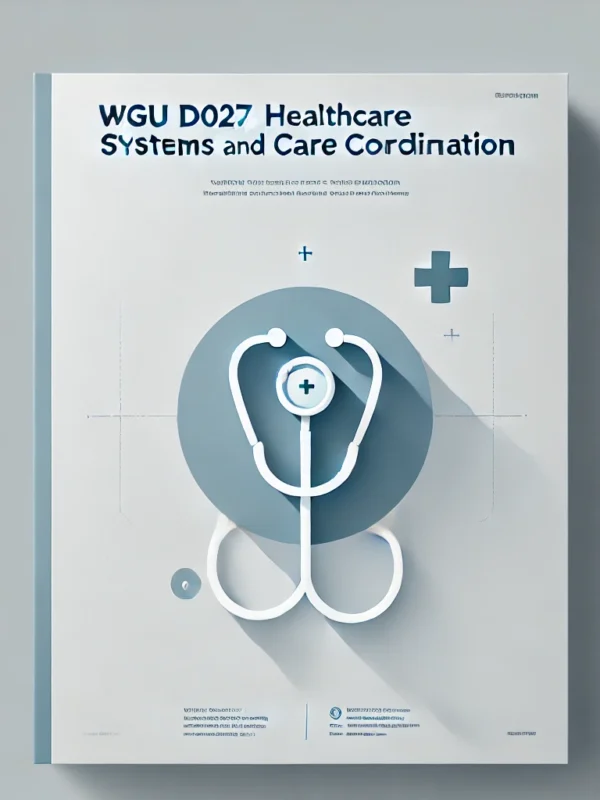Achieve your NCC Electronic Fetal Monitoring (EFM) Certification with this all-inclusive guide, offering a complete review, test prep, and practice questions to ensure success. Perfect for nurses, midwives, and healthcare professionals, this resource provides an in-depth review of EFM essentials, including fetal heart rate patterns, uterine activity, and tracing interpretation, all aligned with NCC standards. It includes strategic test prep to boost your confidence and practice questions that mirror the exam format, complete with detailed explanations to deepen your understanding. Designed for those pursuing NCC certification or seeking to enhance their obstetrics skills, this guide equips you with the tools to excel in electronic fetal monitoring and deliver safe, effective maternal-fetal care.
Preview
1. A Category II tracing:
o A. Predicts abnormal fetal acid-base status
o B. Excludes abnormal fetal acid-base status
o C. Is not predictive of abnormal fetal acid-base status (Correct Answer)
Rationale: Category II tracings are considered indeterminate and do not
reliably predict fetal acid-base status.
2. Plans of the health care team with a patient with a sinusoidal FHR pattern may
include:
o A. Administration of an NST
o B. Administration of tocolytics
o C. Kleinhauer-Betke lab test (Correct Answer)
Rationale: A sinusoidal pattern may indicate fetal anemia, and a Kleinhauer
Betke test can help assess fetal-maternal hemorrhage.
3. Stimulation of the fetal vagus nerve will:
o A. Increase FHR
o B. Decrease FHR (Correct Answer)
o C. Initially increase, then decrease FHR
Rationale: The vagus nerve plays a role in parasympathetic control, slowing
the fetal heart rate when stimulated.
4. Which of the following is not true when assessing preterm fetuses?
o A. FHR baseline may be in upper range of normal (150-160 bpm)
o B. They may have fewer accels, and if <35 weeks, may be 10×10 (Correct
Answer)
o C. Variability may be in lower range for moderate (6-10 bpm)
Rationale: Preterm fetuses do have fewer accelerations, but the definition of
an acceleration remains 15×15 after 32 weeks.
5. One of the side effects of terbutaline as a tocolytic is:
o A. Fetal bradycardia
o B. Increased oxygen consumption (Correct Answer)
o C. Marked variability
Rationale: Terbutaline can lead to increased maternal and fetal oxygen
consumption due to its beta-adrenergic effects.
o A. Predicts abnormal fetal acid-base status
o B. Excludes abnormal fetal acid-base status
o C. Is not predictive of abnormal fetal acid-base status (Correct Answer)
Rationale: Category II tracings are considered indeterminate and do not
reliably predict fetal acid-base status.
2. Plans of the health care team with a patient with a sinusoidal FHR pattern may
include:
o A. Administration of an NST
o B. Administration of tocolytics
o C. Kleinhauer-Betke lab test (Correct Answer)
Rationale: A sinusoidal pattern may indicate fetal anemia, and a Kleinhauer
Betke test can help assess fetal-maternal hemorrhage.
3. Stimulation of the fetal vagus nerve will:
o A. Increase FHR
o B. Decrease FHR (Correct Answer)
o C. Initially increase, then decrease FHR
Rationale: The vagus nerve plays a role in parasympathetic control, slowing
the fetal heart rate when stimulated.
4. Which of the following is not true when assessing preterm fetuses?
o A. FHR baseline may be in upper range of normal (150-160 bpm)
o B. They may have fewer accels, and if <35 weeks, may be 10×10 (Correct
Answer)
o C. Variability may be in lower range for moderate (6-10 bpm)
Rationale: Preterm fetuses do have fewer accelerations, but the definition of
an acceleration remains 15×15 after 32 weeks.
5. One of the side effects of terbutaline as a tocolytic is:
o A. Fetal bradycardia
o B. Increased oxygen consumption (Correct Answer)
o C. Marked variability
Rationale: Terbutaline can lead to increased maternal and fetal oxygen
consumption due to its beta-adrenergic effects.












Reviews
There are no reviews yet.